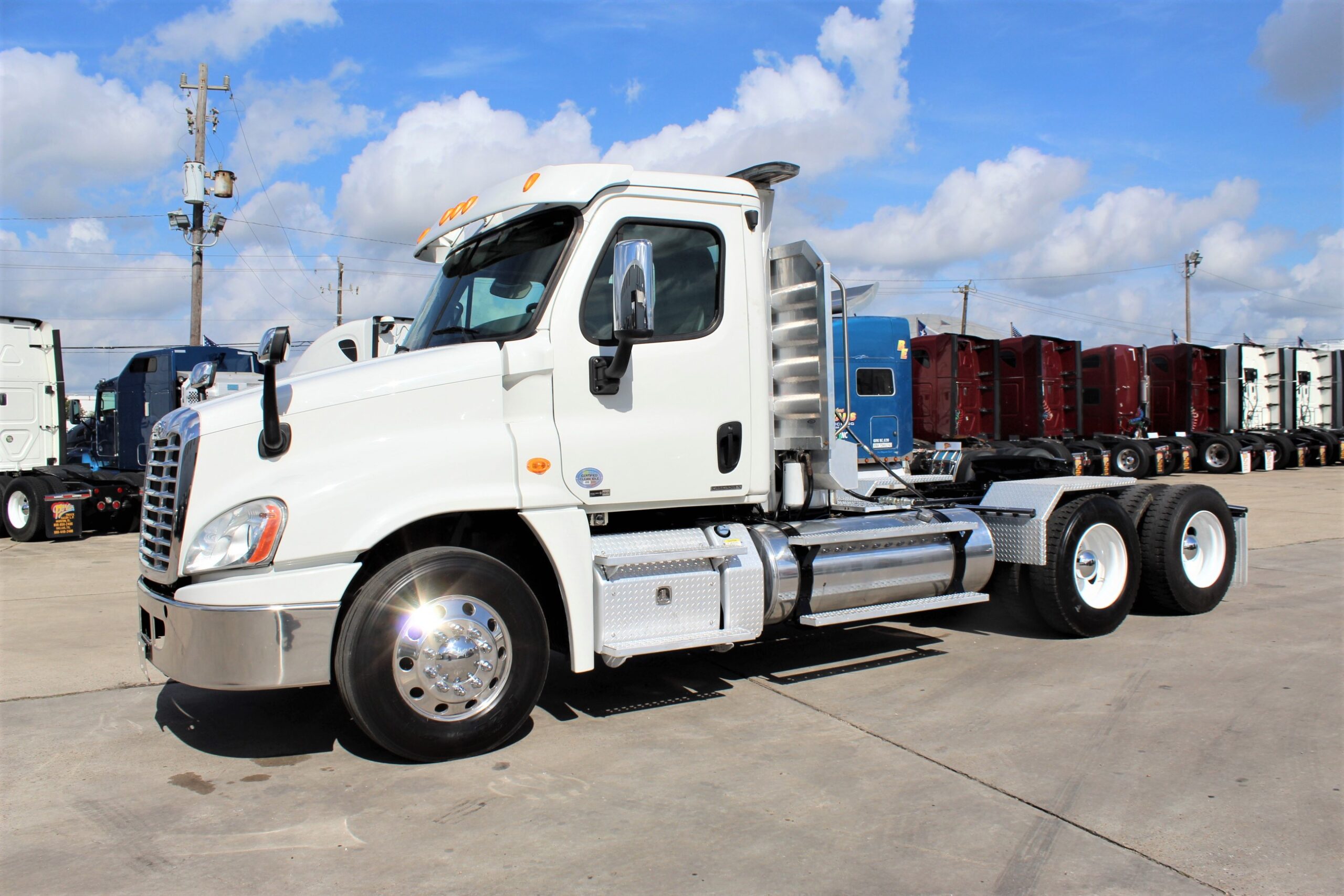Semi Truck Kelley Blue Book: Navigating the Complex World of Commercial Vehicle Valuation pickup.truckstrend.com
For most consumers, the name "Kelley Blue Book" is synonymous with vehicle valuation. It’s the go-to resource for understanding what your car, motorcycle, or RV is worth, whether you’re buying, selling, or trading in. However, when it comes to the heavy-duty world of semi-trucks, the landscape of valuation is significantly more complex, and a direct "Semi Truck Kelley Blue Book" doesn’t exist in the same readily accessible, consumer-friendly format.
This article aims to demystify semi-truck valuation, exploring why a direct KBB equivalent isn’t available, what resources professionals use, the critical factors influencing a truck’s value, and how to approach the buying or selling process with confidence. Consider this your comprehensive guide to understanding the "Kelley Blue Book principle" applied to the specialized realm of commercial trucking.
Semi Truck Kelley Blue Book: Navigating the Complex World of Commercial Vehicle Valuation
The Myth and Reality: Why There’s No Direct "Semi Truck Kelley Blue Book"
The primary reason Kelley Blue Book doesn’t publish valuations for semi-trucks is a matter of market specialization and complexity. The passenger vehicle market, which KBB serves, deals with millions of relatively standardized units. While options vary, the core components and expected lifespan are somewhat predictable.
Semi-trucks, on the other hand, are highly customized, purpose-built machines. Their value is influenced by a myriad of factors far beyond just make, model, and year:
- Infinite Configurations: From engine size and horsepower to transmission type (manual vs. automated manual), axle configurations, sleeper size, and specialized equipment (wet kits, PTOs, APUs), no two trucks are exactly alike.
- Usage and Wear: A semi-truck’s value is heavily tied to its operational history. Was it a long-haul truck accumulating millions of miles, or a local delivery truck with frequent stops? Engine hours often matter more than mileage.
- Maintenance Records: Commercial trucks are revenue-generating assets. Their value is directly proportional to their reliability and expected remaining service life, which is heavily dictated by meticulous maintenance.
- Market Niche: The demand for a specific type of truck (e.g., flatbed vs. reefer vs. dump truck) can fluctuate significantly based on economic conditions, freight rates, and regional industry needs.
- High Value, High Risk: These are expensive assets, and errors in valuation can lead to substantial financial losses for buyers, sellers, lenders, and insurers.

Due to this immense variability and the specialized nature of the market, a single, standardized "blue book" for semi-trucks would be impractical and potentially misleading.
So, How ARE Semi-Trucks Valued? Key Valuation Resources
While a single "Semi Truck Kelley Blue Book" doesn’t exist, the commercial trucking industry relies on several reputable sources and methods to assess truck values:

- Truck Blue Book (Official Commercial Truck Guide): This is arguably the closest equivalent to a "KBB for trucks." Published by the National Automobile Dealers Association (NADA) Guides, the Official Commercial Truck Guide (often still referred to as "Truck Blue Book") provides wholesale and retail values for a vast array of medium and heavy-duty trucks, including semi-trucks. It factors in mileage, condition, and common specifications.
- Auction Results: Online and physical auction houses like Ritchie Bros. Auctioneers, IronPlanet, and TruckPlanet provide transparent sales data for thousands of trucks. Their past auction results are an invaluable resource for understanding real-world market prices.
- Dealer Networks and Industry Experts: Reputable truck dealerships have vast experience and access to proprietary sales data. They often employ appraisers or sales managers who specialize in valuing used equipment. Independent commercial vehicle appraisers also exist, offering certified valuations.
- Online Marketplaces: Websites like TruckPaper.com, CommercialTruckTrader.com, and MyLittleSalesman.com list thousands of trucks for sale, offering a snapshot of asking prices. While these are asking prices, not necessarily selling prices, they provide a good range for comparison.
- Industry Publications and Data Providers: Various industry reports, economic forecasts, and data analytics firms track trends in freight rates, fuel prices, and new truck production, all of which influence used truck values.

Factors Influencing Semi-Truck Value: A Deep Dive
Understanding the key determinants of a semi-truck’s worth is crucial for both buyers and sellers. Here are the most significant factors:
- Make and Model: Certain brands like Peterbilt, Kenworth, Freightliner, Volvo, and Mack have strong reputations for reliability, longevity, and resale value. Specific models within these brands also carry different values.
- Year of Manufacture: Newer trucks generally command higher prices, but the depreciation curve for semi-trucks can be less steep than for passenger cars, especially for well-maintained models.
- Mileage and Engine Hours: Unlike cars, engine hours can be as, or more, important than mileage, especially for vocational trucks or those that idle extensively. Lower mileage/hours usually mean higher value.
- Engine Type and Horsepower: The engine is the heart of the truck. Popular, reliable engine models (e.g., Cummins, Detroit Diesel, PACCAR) with good horsepower (typically 450-550 HP for over-the-road trucks) are highly desirable. Emissions compliance (e.g., EPA 2010, GHG17) also plays a huge role.
- Transmission Type: While manual transmissions were once standard, automated manual transmissions (AMTs) are increasingly popular due to fuel efficiency and ease of operation. The type and condition of the transmission significantly impact value.
- Axle Configuration and GVWR: Tandem axle trucks are standard for most long-haul applications, but specialized configurations (tridem, lift axles) for specific weight requirements or vocational uses will affect value. Gross Vehicle Weight Rating (GVWR) and Gross Combined Weight Rating (GCWR) are also important.
- Sleeper Size and Amenities: Sleeper cabs range from day cabs (no sleeper) to ultra-large custom sleepers. The size, condition, and amenities (APU, refrigerator, inverter, microwave, TV mount) directly impact the value for long-haul operations.
- Overall Condition (Mechanical and Cosmetic): This is paramount.
- Mechanical: Engine health (oil analysis, diagnostic codes), transmission, differentials, brakes, suspension, tires (tread depth, brand), fifth wheel, air system, electrical system. Any major known issues will drastically reduce value.
- Cosmetic: Exterior (paint, chrome, dents, rust), interior (seat condition, dash integrity, cleanliness). A well-maintained appearance suggests a well-maintained truck.
- Maintenance Records: Comprehensive, verifiable maintenance records are gold. They provide a transparent history of service, repairs, and preventative care, indicating the truck’s reliability and extending its perceived lifespan.
- Special Features/Customizations: Items like wet kits (for dump trailers, walking floors), power take-offs (PTOs), auxiliary power units (APUs), custom lighting, or specialized bodies (e.g., dump, mixer, refuse) add significant value for specific applications.
- Market Demand and Economic Conditions: Freight rates, fuel prices, interest rates, and the overall economic climate profoundly impact the demand for new and used trucks. A strong economy with high freight volumes typically drives up used truck prices.
- Region: Truck values can vary regionally based on local industry needs, climate (e.g., rust in northern states), and population density.
The Valuation Process: A Step-by-Step Guide
Whether you’re buying or selling, a structured approach to valuation is essential:
- Define Your Truck’s Specifications: Gather every detail: Make, model, year, VIN, engine type (make, model, HP), transmission type, axle configuration, mileage, engine hours, sleeper size, and any special features.
- Compile Maintenance and Repair Records: For sellers, have these organized and ready. For buyers, demand them. This is the single most important factor for establishing trust and verifying the truck’s health.
- Thorough Condition Assessment:
- Self-Inspection: Do a comprehensive walk-around, check fluids, look for leaks, test lights, check tire wear, and assess interior condition.
- Professional Inspection (Highly Recommended): For buyers, invest in a pre-purchase inspection (PPI) by an independent, qualified heavy-duty mechanic. This can uncover hidden issues and save significant money in the long run. For sellers, addressing minor issues identified can increase value.
- Research Comparable Sales (Comps):
- Auction Data: Check recent sales on Ritchie Bros., IronPlanet, etc., for trucks similar to yours. These provide actual transaction prices.
- Dealer Listings: Browse TruckPaper, CommercialTruckTrader, etc. Filter by similar specs. Remember these are asking prices.
- NADA Truck Blue Book: Use this as a foundational guide for wholesale and retail values, adjusting for your truck’s specific condition and features.
- Consult Industry Experts: Talk to reputable truck dealers, brokers, or independent appraisers. They have their finger on the pulse of the market.
- Factor in Market Trends: Are freight rates up or down? Are new truck orders backlogged? Is fuel expensive? These macro factors can swing prices.
- Consider Regional Differences: Be aware that values can vary geographically.
Benefits of Accurate Valuation
- For Sellers: Sets a realistic asking price, attracts serious buyers, facilitates a quicker sale, and prevents undervaluing a valuable asset.
- For Buyers: Ensures a fair purchase price, helps in budgeting for maintenance, and provides confidence in the investment.
- For Lenders and Insurers: Essential for loan approvals, collateral assessment, and determining appropriate insurance coverage and payouts in case of damage or loss.
Challenges and Solutions
- Challenge: High Variability: Every truck is unique, making direct comparisons difficult.
- Solution: Focus on core specs, and then adjust for individual features, condition, and maintenance history. A professional appraisal is invaluable for unique or highly customized trucks.
- Challenge: Market Fluctuations: Semi-truck values can change rapidly due to economic shifts.
- Solution: Stay informed on industry news, freight rates, and fuel prices. Be prepared to adjust your price if selling, or seize opportunities if buying.
- Challenge: Lack of Centralized Data: No single, perfect "Semi Truck Kelley Blue Book."
- Solution: Utilize multiple resources – NADA, auction data, dealer insights, online listings, and professional appraisals – to build a comprehensive picture.
- Challenge: Condition Assessment Subjectivity: "Good condition" can mean different things to different people.
- Solution: Rely on objective data like professional inspections, diagnostic reports, and detailed maintenance logs. For sellers, be transparent; for buyers, be diligent.
Representative Semi-Truck Valuation Guide (Inspired by KBB Principles)
While there isn’t a direct "Semi Truck Kelley Blue Book" with specific price points for every model, we can illustrate the factors that influence value, similar to how KBB provides adjustments for mileage, options, and condition. This table outlines key elements and their general impact on a semi-truck’s potential market value.
| Factor | Description | Impact on Value Semi-Truck Valuation is essentially trying to determine the fair market value of a semi-truck. This value is used by buyers, sellers, banks, and insurance companies.
Frequently Asked Questions (FAQ)
Q1: Is there a "Kelley Blue Book" specifically for semi-trucks?
A1: No, not in the same way there is for passenger cars. The semi-truck market is highly specialized and complex, making a single, universal "blue book" impractical. However, resources like the NADA Official Commercial Truck Guide (often called "Truck Blue Book") and extensive auction data serve a similar purpose.
Q2: What is the single most important factor determining a semi-truck’s value?
A2: While many factors are crucial, the truck’s overall mechanical condition and verifiable maintenance history are arguably the most critical. A well-maintained truck with documented service records will always command a higher price, regardless of age or mileage, as it suggests reliability and a longer remaining service life.
Q3: Should I get a professional appraisal for a semi-truck?
A3: For significant purchases or sales, especially of higher-value or specialized trucks, a professional pre-purchase inspection (PPI) by an independent heavy-duty mechanic is highly recommended for buyers. For sellers, a professional appraisal can provide an unbiased, certified valuation that builds buyer confidence.
Q4: How do economic conditions affect semi-truck prices?
A4: Economic conditions have a profound impact. When the economy is strong and freight volumes are high, demand for trucks (and thus their prices) tends to increase. Conversely, a downturn in freight or rising fuel costs can lead to an oversupply of trucks and depressed prices. Interest rates also affect financing costs for buyers, influencing demand.
Q5: Where can I find reliable valuation data for semi-trucks?
A5: Key resources include:
- NADA Official Commercial Truck Guide (Truck Blue Book)
- Auction results from sites like Ritchie Bros. and IronPlanet
- Listings on major commercial truck marketplaces (TruckPaper.com, CommercialTruckTrader.com)
- Consultation with reputable truck dealers and independent appraisers.
Q6: Do emissions standards impact a truck’s value?
A6: Absolutely. Trucks that meet newer emissions standards (e.g., EPA 2010, GHG17) are often more desirable due to potential fuel efficiency benefits and compliance with various state or regional regulations, which can significantly affect their resale value, especially in specific markets like California. Older, pre-emissions trucks might have a niche market but could face restrictions.
Conclusion
While the term "Semi Truck Kelley Blue Book" might be a misnomer, the underlying principle of seeking accurate, informed valuation remains paramount in the commercial trucking industry. The market for semi-trucks is dynamic, complex, and driven by factors far more intricate than those affecting passenger vehicles.
For both buyers and sellers, success hinges on thorough research, understanding the myriad factors that influence value, leveraging specialized industry resources like the NADA Truck Blue Book and auction data, and critically, investing in professional inspections and maintaining meticulous records. By adopting a diligent and comprehensive approach, you can navigate the semi-truck market with confidence, ensuring you get a fair deal whether you’re adding to your fleet or selling a valuable asset.
